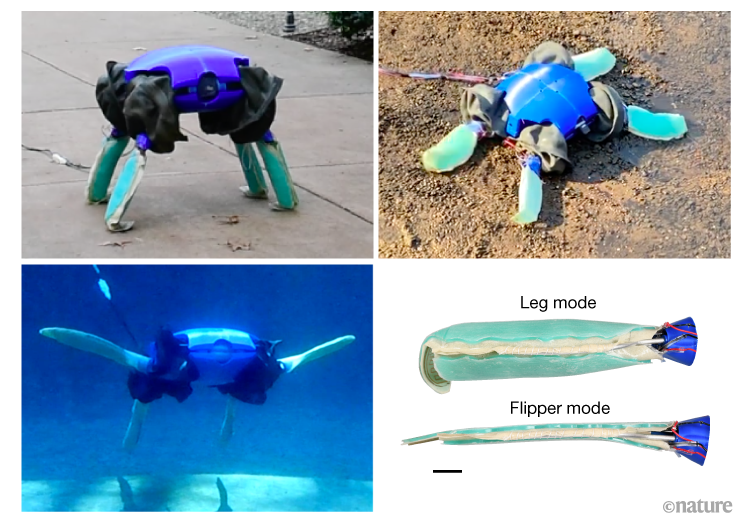The majority of robots are usually built to work in a localized point. Using such a uniform set of hardware devices to change a robot's body structure and physical movement allows it to travel effectively in diverse situations, for instance, on land and underwater.
This week's issue of Nature features robotics that could switch between tortoise and turtle shapes to move throughout the land and aquatic habitats. This research proposes an approach for enhancing robotics development that could also move effectively in various settings.
Amphibious automatons that can travel across and through water might have practical uses in bio-monitoring, search and rescue operations, security, and a method to investigate wildlife movement.
Influenced by turtles but also their ground relatives, tortoises, Rebecca Kramer-Bottiglio, and associates create adaptable robotics featuring limbs that can alter to best represent the terrain. This Amphibious Robotic Turtle or ART might change its stride and the form of its limbs. Across the land, its legs have a load-bearing shape similar to a tortoise's. The material used to build those limbs may change in stiffness and morph into flat paddles, letting the robot paddle like a turtle through the fluid.
Amphibious Robotic Turtle's Mission
Kramer-Bottiglio labs have worked on technologies such as observing ecosystems alongside seashores, diver assistance, and ocean agriculture. This robot will therefore aid scientists in their investigation into the mechanics of mobility in the complicated surf zone - wherein waves, current flow, and turbidity render navigation especially challenging for robotic systems - as well as other environment system boundaries, according to the press release from Yale University.
Moreover, the authors suggest that the morphing method used in this work may aid in creating a new generation of automated systems that could continuously modify their structures for maximum effectiveness throughout different circumstances.

The Amphibious Robotic Turtle. This little robot can take on adventures on solid ground and underwater.
ALSO READ: Indestructible Robotic Animal 'Mini Cheetah' Can Run 9mph in Gravel, Ice, and Any Terrain
Earlier Robotic Innovation
Later in Dec. last year, mechanical arms with human-like hands seemed to be more versatile than just the simple two-pronged grips used on robotic systems, but they cannot match their sturdiness. This robotic hand featuring sticky rubbery skin influenced by gecko feet blends the best of both worlds: it can selectively select up a grape while simultaneously carrying big things.
Geckos' feet are coated with microscopic hairs that break into even smaller strands, each of which creates a molecular affinity to the substrate the creature is climbing on, as reported by New Scientist.
Mark Cutkosky of Stanford University in California, along with his colleagues, previously established materials that replicate how a gecko's foot attaches on smooth surfaces and afterward utilized these in robotics, a few of which are meant to latch onto a single layer on a satellite.
Whenever examining natural ecosystems, there is constantly the danger that the mere presence of human beings will affect or adversely affect what we, the researchers, are attempting to see. Scientists continually look for improved methods for investigating natural events while limiting human effects. Placing cameras or detectors helps, but their coverage is restricted, particularly in an undersea setting where the exploring area stretches throughout every dimension, according to a Slash Gear report.
RELATED ARTICLE: AI-Powered Robot in China Gives Birth to Seven Piglets, Marks Success of First-Ever Automated Animal Cloning Technique
Check out more news and information on Robotics in Science Times.




![Earth's Quasi-Moon Kamo‘oalewa Could Originate From Lunar Surface Not Asteroid Belt [Study]](https://1721181113.rsc.cdn77.org/data/thumbs/full/53275/89/56/50/40/earths-quasi-moon-kamo-oalewa-could-originate-from-lunar-surface-not-asteroid-belt-study.png)









